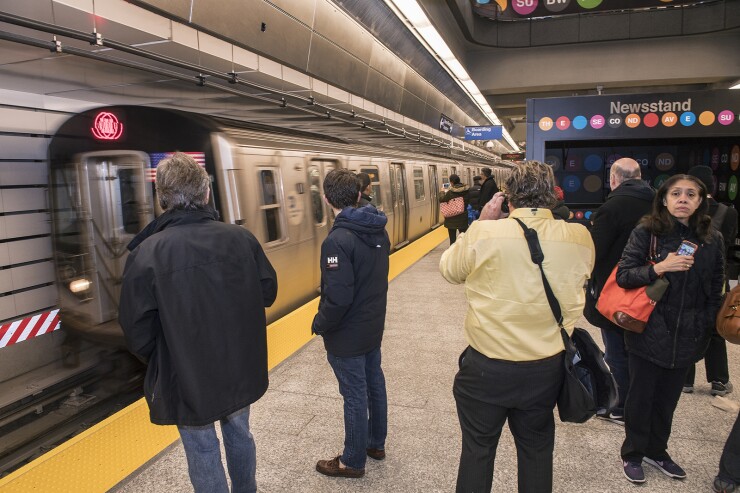New York's Metropolitan Transportation Authority is sending its record $51.5 billion
Beyond that lie layers of complexity for the agency that operates mass transit in the New York City region.

Unknowns for now include the effects on debt levels and rating agency perceptions for one of the largest municipal issuers with roughly $44 billion in debt including special credits; and the levels of efficiency in negotiating labor agreements and implementing congestion pricing for Manhattan beginning in 2021.
The single largest source of funds for the plan — $25 billion — comes from bonds backed by new revenue streams authorized in the fiscal 2020 state budget, including $15 billion from congestion pricing for Manhattan.
The MTA anticipates receiving $10.7 billion from federal funding programs. Another $10 billion will come from bonds backed by new revenue sources dedicated to public transportation: a progressive tax on high-end real estate sales and an Internet sales tax.
Gov. Andrew Cuomo, who effectively runs the MTA, has pledged $3 billion of state funds subject to legislative approval, and the plan assumes New York Mayor Bill de Blasio will pledge an equal amount.
The remaining $9.8 billion will come from the MTA through pay-as-you-go capital contributions and bonds backed by longstanding dedicated taxes, fares and revenues from existing tolls.
Discussion over city funding levels has reignited the city-state conflict, a multi-generational phenomenon in New York transit politics.
De Blasio said Wednesday the city wouldn't contribute the $3 billion until the MTA uses all its expected $25 billion in new revenue. The mayor also wants to know the findings of a forensic audit of the authority that Cuomo ordered — it may be available by year's end — and for the capital plan to reflect city transit priorities.
“We look forward to continuing the conversation with the city in the weeks ahead,” said MTA Chairman Patrick Foye, who added that much of the new revenue is lockboxed for capital projects.
S&P Global Ratings called five-year plan “indeterminate” as a credit risk. “Given the new program's preliminary nature, which still requires approval, timing of its implementation and impact to MTA key credit metrics is not yet available,” S&P said.
Two new MTA credits are in the works, according to finance director Patrick McCoy.
The authority is requesting capital program review board approval of a payroll mobility tax credit resolution that would pledge revenues from the tax enacted in 2009, as well as the ability to pledge additional revenues to secure second lien obligations if needed. The MTA began floating the idea in 2013.
“We’re continuing to be hopeful that this will ultimately win approval,” McCoy said. “We’ve structured a credit that we believe will achieve high double-A credit ratings from all the rating agencies.”
S&P twice last year downgraded the MTA’s workhorse transportation revenue bonds, landing at A with a negative outlook. In December, Moody’s Investors Service revised its outlook to negative from stable while affirming its A1 rating.
Fitch Ratings has maintained its AA-minus rating since upgrading from A in June 2017. Kroll Bond Rating Agency assigns AA-plus with a negative outlook.
In addition, a sales tax obligation resolution would secure new revenue from statewide and citywide sales and compensating use taxes, which Albany passed as part of the state fiscal 2020 budget to fund MTA capital needs.
McCoy said the authority could derive at least $5 billion from issuing bonds against the revenues.
While the capital program from 2020 to 2024 has generated much buzz, the state-run authority still must cope with operating deficits that could soar to $1 billion by 2023. The board must vote on the operating budget for the calendar year by Dec. 31.
“There’s not a lot of talk about how to pay for operating deficits or how to negotiate the labor contracts,” said Howard Cure, director of municipal bond research for Evercore Wealth Management. “I really think that to bring down some of the costs both in operating and capital, you have to implement some work-rule changes to get more efficiencies out of these construction projects.”
The authority faces some hard decisions, Cure added.

“What are the priorities … the maintenance of the system, the less glamorous aspects like signaling vs. the new Second Avenue subway."
Kroll said pending labor contract negotiation and renewal, notably with Transport Workers Union 100, present opportunities to close the budget gap or they could pose risks of widening it. Any TWU agreement is expected to set a bargaining pattern.
"Past capital programs have relied too heavily on fare-backed borrowing, squeezing resources for service provision and pushing up fares,” said the civic organization TransitCenter.
The authority could derive operating cost savings from its so-called transformation plan, which the board approved in July, though for now the reorganization is little more than a blueprint.
Critics say the restructuring, which ostensibly could streamline functions within the MTA’s balkanized agencies, could create additional high-end bureaucratic layers, such as the creation of a chief transformation officer.
“Transformation? Can you put that in English?” said Trudy Mason of the New York City Transit Riders Council. “To me, having experienced so much of the gobbledygook of the MTA over the years, this takes the cake."
Challenges for the MTA extend beyond aging infrastructure and bloated bureaucracy. They include alternative transportation modes including bicycles and app-based ride-sharing companies.
"The MTA has now gotten a lot of competition from Uber and Lyft,” said Mitchell Moss, director of New York University’s Rudin Center for Transportation Policy and Management.
The MTA’s biggest mistakes over the years, according to Moss, include not buying Penn Station and not tightening work rules.
Key recommendations on congestion pricing by think tank





